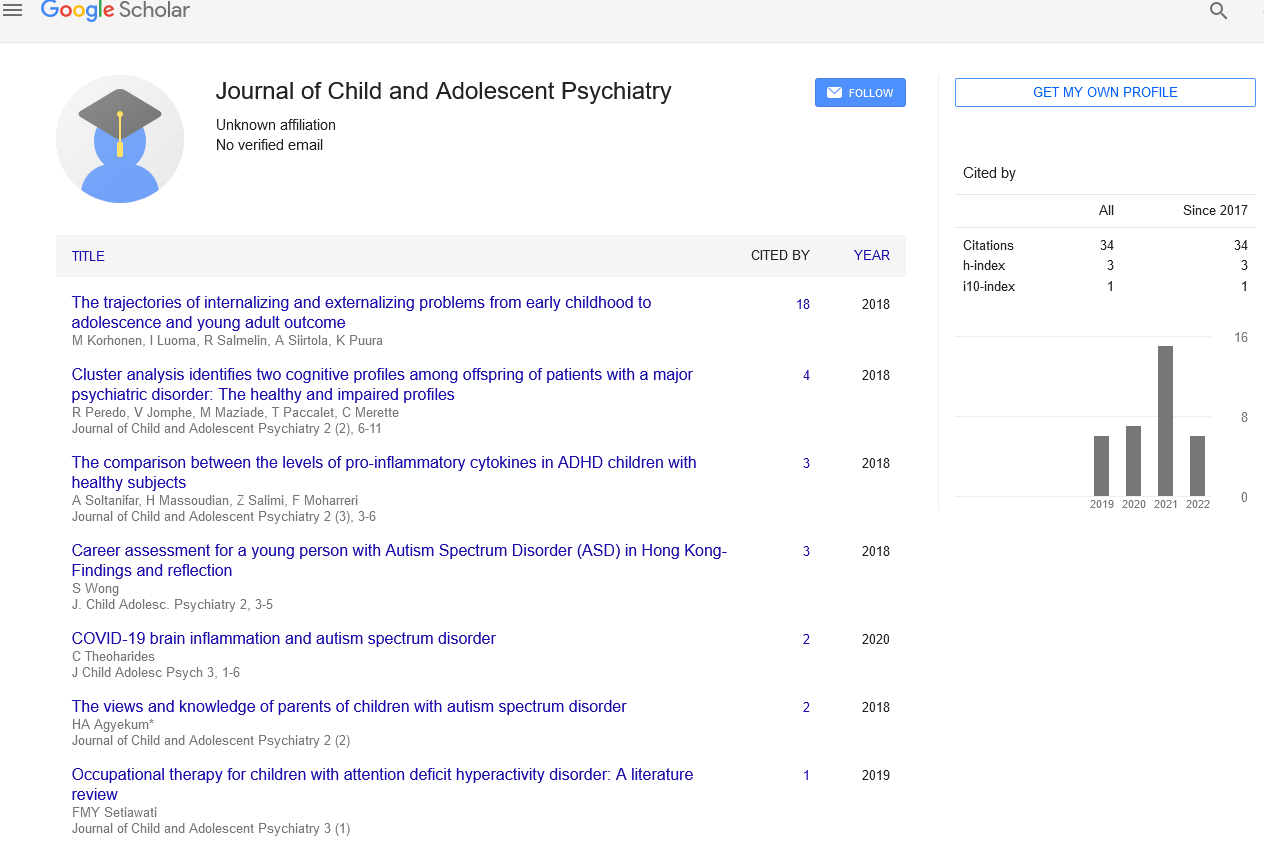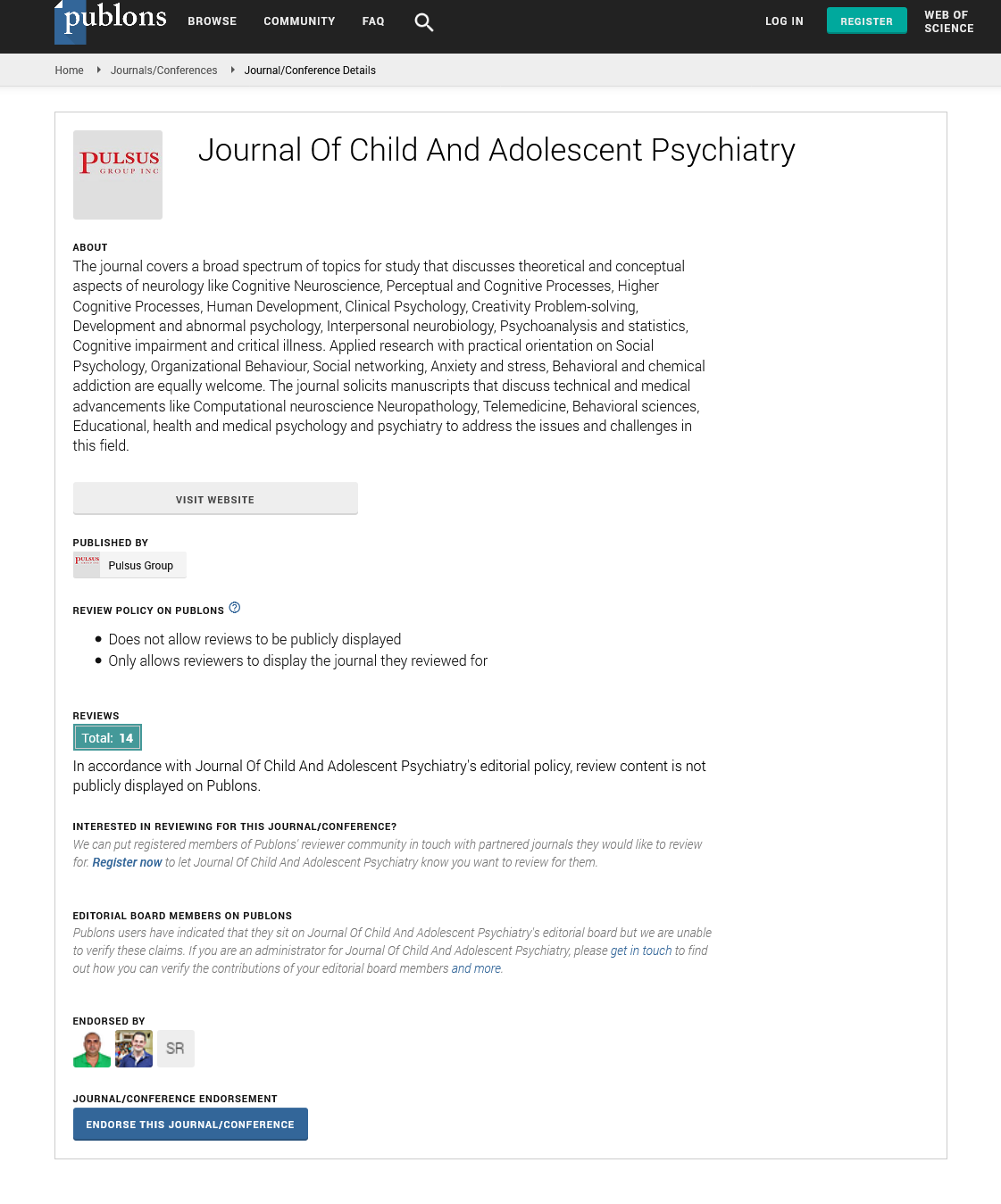A note on social anxiety disorder
Received: 11-Nov-2021 Accepted Date: Nov 25, 2021; Published: 02-Dec-2021
Citation: Wang M. A note on social anxiety disorder.Child Adolesc Psych. 2021;5(5);.1-2
This open-access article is distributed under the terms of the Creative Commons Attribution Non-Commercial License (CC BY-NC) (http://creativecommons.org/licenses/by-nc/4.0/), which permits reuse, distribution and reproduction of the article, provided that the original work is properly cited and the reuse is restricted to noncommercial purposes. For commercial reuse, contact reprints@pulsus.com
Description
Social Anxiety Disorder (SAD), otherwise called social fear, is a tension problem portrayed by feelings of dread and uneasiness in friendly circumstances, making significant misery and disabled capacity work in at minimum a few parts of everyday life. These apprehensions can be set off by apparent or genuine examination from others. People with social uneasiness issue dread antagonistic assessments from others.
Actual manifestations regularly incorporate unreasonable becoming flushed, overabundance perspiring, shaking, palpitations, and sickness. Stammering might be available, alongside quick discourse. Alarm assaults can likewise happen under exceptional dread and distress. A few victims might utilize liquor or different medications to decrease fears and restraints at gettogethers. It is normal for victims of social fear to self-cure in this design, particularly assuming they are undiscovered, untreated, or both; this can prompt liquor use issue, dietary issues or different sorts of substance use issues. Tragic is some of the time alluded to as a disease of lost freedoms where "people settle on significant life decisions to oblige their illness”. According to ICD-10 rules, the vitally indicative models of social fear will be dread of being the focal point of consideration, or dread of acting such that will be humiliating or embarrassing, evasion and uneasiness symptoms. Standardized rating scales can be utilized to evaluate for social nervousness issue and measure the seriousness of tension.
The main line of treatment for social tension issue is intellectual conduct treatment (CBT). Medications, for example, SSRIs are successful for social fear, particularly paroxetine. CBT is viable in treating this problem, regardless of whether conveyed separately or in a gathering setting. The intellectual and conduct parts look to change thought designs and actual responses to uneasiness inciting circumstances. The consideration given to social nervousness problem has fundamentally expanded beginning around 1999 with the endorsement and showcasing of medications for its treatment. Endorsed drugs incorporate a few classes of antidepressants: particular serotonin reuptake inhibitors (SSRIs), serotonin-norepinephrine reuptake inhibitors (SNRIs), and monoamine oxidase inhibitors (MAOIs).Other normally utilized meds incorporate beta blockers and benzodiazepines.
Cognitive aspects
In intellectual models of social tension problem, those with social fears experience fear over how they will present to other people. They might feel excessively reluctant, give high self-consideration later the action, or have elite execution norms for themselves. As per the social brain research hypothesis of self-show, a victim endeavours to make a respectful impression towards others however accepts they can't do as such. Oftentimes previously, the conceivably uneasiness inciting social circumstance, victims may purposely survey what could turn out badly and how to manage each startling case.
Behavioral aspects
Social tension problem is a diligent dread of at least one circumstances in which the individual is presented to conceivable investigation by others and fears that they might accomplish something or act such that will be embarrassing or humiliating. It surpasses typical "bashfulness" as it prompts over the top social aversion and generous social or word related debilitation. Dreaded exercises might incorporate practically any sort of friendly collaboration, particularly little gatherings, dating, parties, conversing with outsiders, cafés, interviews, and so on.
Physiological aspects
Individuals with SAD keep away from circumstances that the vast majority consider "ordinary". They might struggle seeing how others can deal with these circumstances with such ease. Individuals with SAD keep away from all or most friendly circumstances and stow away from others, which can influence their own connections. Social fear can totally eliminate individuals from social circumstances because of the unreasonable dread of these circumstances. Individuals with SAD might be dependent via webbased media organizations, have lack of sleep, and feel great when they keep away from human collaborations.
Causes
Examination into the reasons for social tension and social fear is widerunning, including different points of view from neuroscience to humanism. Researchers presently can't seem to pinpoint the specific causes. Studies propose that hereditary qualities can have an influence in mix with ecological variables. Social fear isn't brought about by other mental issues or substance use. Generally, social nervousness starts at a particular point in a singular's life. This will create over the long haul as the individual battles to recuperate. In the long run, gentle social ungainliness can form into side effects of social uneasiness or fear. Aloof online media use might cause social nervousness in certain individuals.
Treatment
The primary line treatment for social tension issue is intellectual conduct treatment (CBT) with meds like specific serotonin reuptake inhibitors (SSRIs) utilized uniquely in the people who are not intrigued by therapy. Self-help dependent on standards of CBT is a second-line treatment.
There is some arising proof for the utilization of acknowledgment and responsibility treatment (ACT) in the treatment of social tension issue. ACT is viewed as a branch of customary CBT and stresses tolerating upsetting indications rather than battling against them, just as mental adaptability the capacity to adjust to changing situational requests, to move one's viewpoint, and to adjust contending desires. ACT might be helpful as a second line treatment for this problem in circumstances where CBT is insufficient or refused.
A few investigations have proposed social abilities preparing (SST) can assist with social anxiety. Examples of social abilities zeroed in on during SST for social nervousness issue include: starting discussions, building up kinships, cooperating with individuals from the favoured sex, developing a discourse and confidence skills. However, it isn't certain if explicit social abilities strategies and preparing are required, as opposed to simply supporting with general social working and openness to social situations.
Given the proof that social tension issue might foresee resulting advancement of other mental issues, for example, gloom, early conclusion and treatment is important. Social uneasiness problem stays underperceived in essential consideration practice, with patients regularly introducing for treatment solely after the beginning of intricacies, for example, clinical wretchedness or substance use issues.






